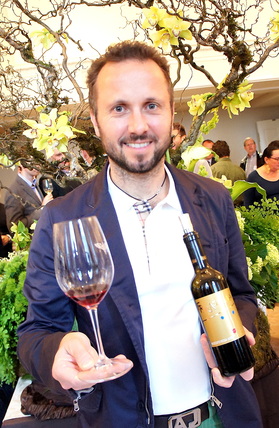 The gent holding the bottle is Andi Punter, export manager for Franz Haas, a winery that's been in business since 1881. The Haas family has about 125 acres in a tiny region of northern Italy called Alto Adige, which grows barely one percent of Italy's wine.
The gent holding the bottle is Andi Punter, export manager for Franz Haas, a winery that's been in business since 1881. The Haas family has about 125 acres in a tiny region of northern Italy called Alto Adige, which grows barely one percent of Italy's wine.
The limited supply didn't deter the region's consortium of wine producers from holding a seminar and tasting in Seattle last week, however.
Alto Adige, on Italy's border with Austria, is known also as Süd Tirol; German is one of its official languages. The Adige river forms a deep and wide valley (good land for apple trees), while the surrounding hillsides are covered in steep Alpine forests and about 30,000 acres of vineyards (roughly comparable to Washington State, though at much higher elevations). The altitude guarantees 300 days of warm sunshine, while the northerly latitude produces sharp differences between daytime high temperatures and nighttime lows (again, comparable to Washington).
Annual wine production, by 15 coöps and over 100 independent growers, hovers around 9 million gallons (45 million bottles), a third of which is exported, mostly to neighboring Germany and Switzerland, though the United States does import a goodly amount. The most widely planted white varieties are internationally known standbys pinot grigio, gewurztraminer, chardonnay and pinot blanc; the two leading reds, on the other hand, are indigenous: schiava and lagrein, followed by pinot noir, merlot and cabernet.
Just one third of one percent of the Alto Adige's grapes are a variety called moscato rosa, and that's what's in the Franz Haas bottle. The backstory is fascinating. Vinifera vines are hardy and resourceful plants; their roots will burrow through bedrock to reach moisture, their DNA programs them to produce vast numbers of offspring (the seeds inside the grapes). What we think of as viticulture is basically the grower's attempt to curb and channel the plant's reproductive enthusiasm into a limited number of grapes. First, though, the stamens of the budding fruit must be pollinated. Vinifera plants are normally self-pollinating, but the Alpine winds in the Alto Adige overpower the buds of moscato rosa. Instead, as Andi Punter explained to me, the growers have to wait for bees to visit the vineyards.
Is that why the Franz Haas moscato rosa has aromas of roses? Cloves, too! More so here than elsewhere (Alsace, Portugal, Sicily) where the grape is used to make sparkling pink wines that have a candied flavor. In any event, there's not that much moscato rosa to begin with; yields are very low compared to other varieties. It's not a late harvest or a passito, it's just a remarkable wine. The Franz Haas bottling is regularly awarded the coveted "Tre Bichieri" rating by Italy's benchmark Gambero Rosso wine guide. The half bottle sells for $49
One final note: tourism is a huge draw for this region, which counts 250,000 hotel beds and another 400,000 accommodations in guest houses and the like. People come for the skiing in winter, the hiking in summer, the spectacular scenery year-round. They eat the local speck, they drink the local wine, they go home happy.
Leave a comment